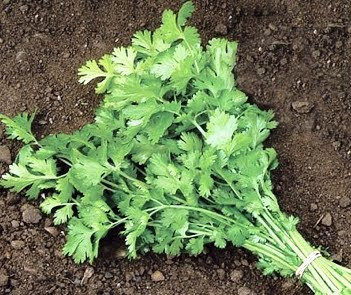 |
| How to grow coriander from seed? |
Coriander is now one of the most common herbs in use today. It is superb at livening up salads and is an essential ingredient in many Asian dishes. Its recent popularity may be due in part to the plants culinary adaptability. This is because both the seeds and the leaves of the coriander plant can used in cooking. The seeds have a slight lemony flavour and are often ground up and used as a spice. The leaves however have a fresh and slightly bitter taste, and these are usually chopped up and added to dishes, soups, breads or used raw as a garnish.
 |
| How to grow coriander from seed? |
While these techniques can show excellent results when growing a plant to a required size, in the quickest possible time, they are not designed to grow a plant with the best possible flavours. However, this can be improved by repotting supermarket plants into a good quality soil based compost followed by hardening the plants off for a suitable position outside. Just be aware that it may take a few weeks before you end up with a decent tasting plant!
PROPAGATION
Coriander is easily grown from seed, but because the roots are very sensitive to disturbance they should be grown in pots, modular trays, or better still sown directly outside into their final position. Be aware that transplanting young coriander plants outside into their final position can stress them to a point where they will bolt and go to seed. Of course this is fine if you are growing coriander for its seeds, but not if you are growing coriander for its leaves! Refrain from giving coriander plants additional plant feed such as a weekly liquid fertiliser as this too will also encourage it to bolt.
 |
| Coriander seedling |
Using a suitable sized pot or container – it will need to be at least 6 inches deep so that the root system can develop – fill it with a good quality multi-purpose compost such as John Innes no 1 or 2. You may wish to mix in horticultural grit or perlite to help improve drainage. Sow seeds into holes around ½ inches deep, with each seed 2 inches apart and then lightly cover with some more compost. You can expect the coriander seed to germinate anytime from a few days up to no more than 3 weeks,. From this point on they will need to be regularly watered making sure that the soil never dries out. Just make sure that the young root systems do not become waterlogged through over watering!
If you're planning on starting your coriander seed outside then you can sow them from late April or early May onwards. This is to ensure warm soil temperatures as coriander seed will not germinate in cold weather. You may be able to start earlier that that if they are sown under the protection of a cloche or small polytunnel.
When direct sowing coriander seed outside choose a sunny, sheltered position, but one that can offer a certain amount of shade during the hottest part of the day in order to keep the foliage soft and flavoursome. If you are growing coriander predominately for its seed then you are better off sowing in full sun without any protection as the hot stressful conditions will trigger flower production far earlier.
 |
| How to grow coriander from seed? |
Once the germinated seedlings have reached a height of between 2-3 inches, the weaker plants can be thinned out to one plant for every 4 –5 inches. That way, each plant has enough room to grow to its full size. If you are growing the coriander for its foliage than make sure that you remove any flowering spikes otherwise the plants will direct all of their energy into producing flowers and seeds and little or no energy into producing leaves.
You can begin harvesting leave from your coriander plants once they have reached 4 inches in height. Picking the older leaves first will help to encourage further plant growth.
In order to maintain plant vigour, apply a liquid feed to the soil or compost every 2 – 3 weeks during the growing period.
TIP. Sow new batches of coriander seed every three weeks to ensure you have a continual supply during the summer.
For related articles click onto the following links:
Grow Cilantro Seed
Growing Chives from Seed
HOW TO GROW BASIL FROM SEED
HOW TO GROW BASIL FROM SEED INDOORS
HOW TO GROW CARAWAY FROM SEED
HOW TO GROW CHAMOMILE
How to Grow Chives
HOW TO GROW CORIANDER FROM SEED
HOW TO GROW COMFREY
HOW TO GROW DILL FROM SEED
HOW TO GROW HERBS FROM SEED
HOW TO GROW LEMONGRASS
HOW TO GROW LEMONGRASS FROM SEED
HOW TO GROW MINT PLANTS
HOW TO GROW OREGANO FROM SEED
HOW TO GROW PARSLEY FROM SEED INDOORS
HOW TO GROW PARSLEY FROM SEED IN OUTSIDE BEDS
HOW TO GROW SAGE
HOW TO GROW SAGE FROM SEED
How to Overwinter herbs
TOP TEN HERBS FOR A HERB GARDEN
WHAT IS OREGANO?






















